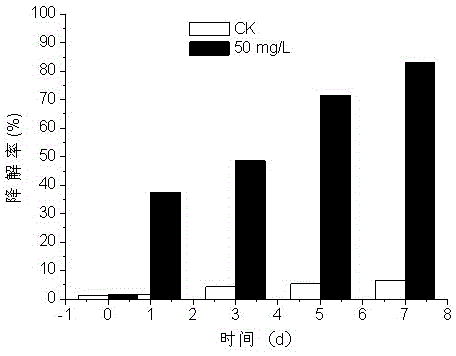Bacillus cereus LGY06 for efficiently degrading napropamide and application and use method of bacillus cereus LGY06
A technology of Bacillus cereus and napropamide, which is applied in the field of microorganisms, can solve problems such as the inability to meet the bioremediation of pesticide residue pollution, and achieve the effects of protecting the ecological environment and human health, good removal effect and low production cost.
- Summary
- Abstract
- Description
- Claims
- Application Information
AI Technical Summary
Problems solved by technology
Method used
Image
Examples
Embodiment 1
[0017] Embodiment 1 of the present invention: Isolation and identification of degrading bacteria LGY06
[0018] 1) Isolation and screening of degrading bacteria LGY06
[0019] Weigh 10.0 g of long-term napropamide-contaminated soil into a 250 mL conical flask, add 100 mL of inorganic salt medium, add napropamide to a concentration of 100 mg / L, and place the conical flask on a shaker (28°C , cultured at 150 rpm for 7 days, took 5 mL of the culture solution and inoculated it into fresh basal medium (herbicide 100 mg / L), and then cultured it in a shaker flask at 28°C for 7 days, and so on for 5 times of inoculation, according to napropamide The concentration gradient of 100 mg / L was increased, so that the concentration of napropamide in the final enriched culture solution reached 500 mg / L, and the enriched degradation strain was obtained.
[0020] During the enrichment and separation of degrading bacteria, after every 2 transfers, the bacterial suspension was prepared into 10 -...
Embodiment 2
[0039] Embodiment 2 of the present invention: preparation of degraded napropamide preparation:
[0040] Including the following steps:
[0041] 1) Cultivate the strain of Bacillus cereus LGY06 in an inorganic salt medium at 30-35°C and 150-200 rpm to the logarithmic growth phase to obtain strains;
[0042] 2) Inoculate the above-mentioned strains into the seed bottle with an inoculum amount of 10% of the volume ratio of the inorganic salt medium, and vibrate at 30-35°C and 150-200 rpm until the logarithmic growth phase to obtain the seed liquid;
[0043] 3) Inoculate the obtained seed liquid into the fermentation medium according to the inoculation amount of 10% by volume, and ferment and cultivate it at 30-35°C and 150-200 rpm for 45-50h to obtain a fermentation liquid, the number of bacteria in the fermentation liquid is greater than 3.0×10 9 cfu / mL, the fermentation broth was directly diluted into a liquid bacterial agent, and the number of bacteria in the liquid bacteri...
Embodiment 3
[0044] Embodiment 3 of the present invention: degradation efficiency of degrading bacteria LGY06 to napropamide
[0045] Napropamide was added to the inorganic salt medium (same as Example 1) to make the final concentration 50.0 mg / L; the inoculation concentration was 2.54×10 8 cfu / mL bacterial agent, and set the culture medium without inoculation as the control, culture in the dark at 30°C (150 rpm) for 0~7d, and take samples regularly. Apply the HPLC method to measure the residual amount of napropamide and calculate the degradation rate, the results are as follows: figure 2 As shown, the results show that the degrading bacteria LGY06 can effectively degrade azoxystrobin in a short period of time, the degradation rate of 50.0 mg / L napropamide within 5 days reached 66.39%, and the degradation rate of 50.0 mg / L napropamide within 7 days The degradation rate reached 76.81%, respectively, which has a good biodegradation effect. In the control without bacteria, the degradation...
PUM
 Login to View More
Login to View More Abstract
Description
Claims
Application Information
 Login to View More
Login to View More - R&D
- Intellectual Property
- Life Sciences
- Materials
- Tech Scout
- Unparalleled Data Quality
- Higher Quality Content
- 60% Fewer Hallucinations
Browse by: Latest US Patents, China's latest patents, Technical Efficacy Thesaurus, Application Domain, Technology Topic, Popular Technical Reports.
© 2025 PatSnap. All rights reserved.Legal|Privacy policy|Modern Slavery Act Transparency Statement|Sitemap|About US| Contact US: help@patsnap.com



